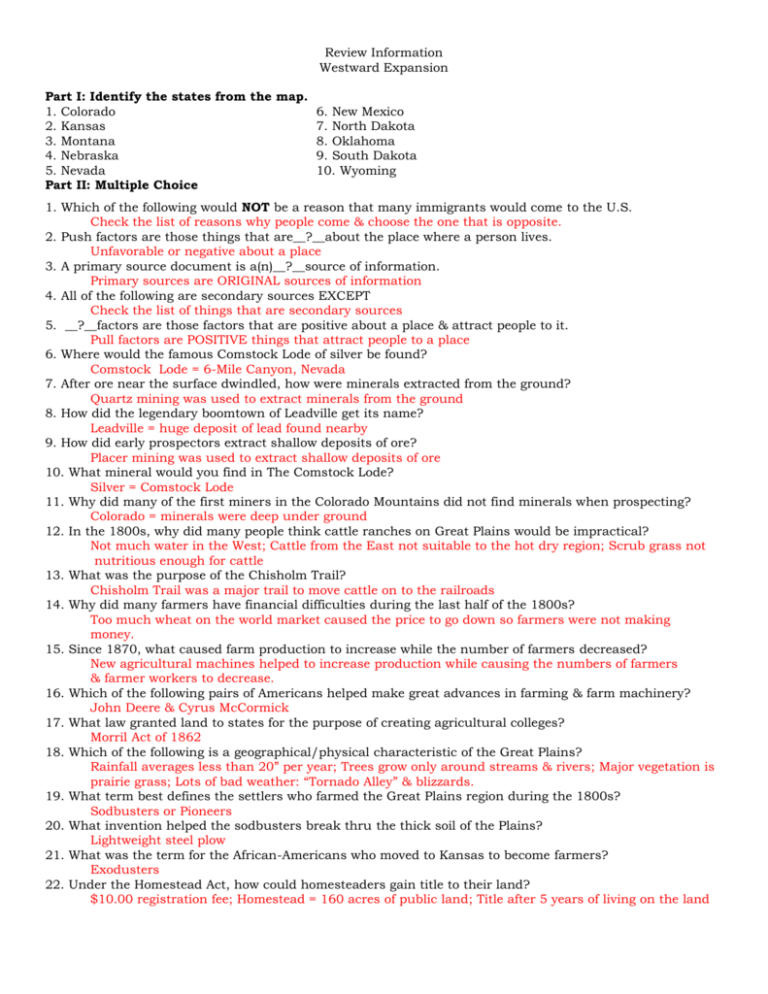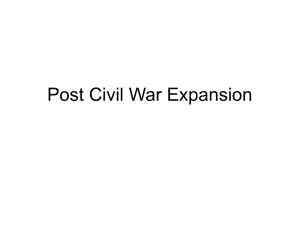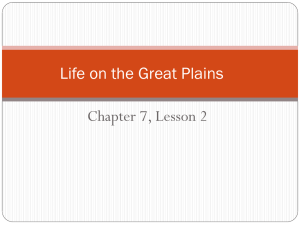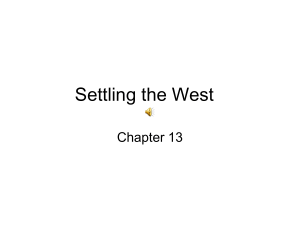File
advertisement

Review Information Westward Expansion Part I: Identify the states from the map. 1. Colorado 6. New Mexico 2. Kansas 7. North Dakota 3. Montana 8. Oklahoma 4. Nebraska 9. South Dakota 5. Nevada 10. Wyoming Part II: Multiple Choice 1. Which of the following would NOT be a reason that many immigrants would come to the U.S. Check the list of reasons why people come & choose the one that is opposite. 2. Push factors are those things that are__?__about the place where a person lives. Unfavorable or negative about a place 3. A primary source document is a(n)__?__source of information. Primary sources are ORIGINAL sources of information 4. All of the following are secondary sources EXCEPT Check the list of things that are secondary sources 5. __?__factors are those factors that are positive about a place & attract people to it. Pull factors are POSITIVE things that attract people to a place 6. Where would the famous Comstock Lode of silver be found? Comstock Lode = 6-Mile Canyon, Nevada 7. After ore near the surface dwindled, how were minerals extracted from the ground? Quartz mining was used to extract minerals from the ground 8. How did the legendary boomtown of Leadville get its name? Leadville = huge deposit of lead found nearby 9. How did early prospectors extract shallow deposits of ore? Placer mining was used to extract shallow deposits of ore 10. What mineral would you find in The Comstock Lode? Silver = Comstock Lode 11. Why did many of the first miners in the Colorado Mountains did not find minerals when prospecting? Colorado = minerals were deep under ground 12. In the 1800s, why did many people think cattle ranches on Great Plains would be impractical? Not much water in the West; Cattle from the East not suitable to the hot dry region; Scrub grass not nutritious enough for cattle 13. What was the purpose of the Chisholm Trail? Chisholm Trail was a major trail to move cattle on to the railroads 14. Why did many farmers have financial difficulties during the last half of the 1800s? Too much wheat on the world market caused the price to go down so farmers were not making money. 15. Since 1870, what caused farm production to increase while the number of farmers decreased? New agricultural machines helped to increase production while causing the numbers of farmers & farmer workers to decrease. 16. Which of the following pairs of Americans helped make great advances in farming & farm machinery? John Deere & Cyrus McCormick 17. What law granted land to states for the purpose of creating agricultural colleges? Morril Act of 1862 18. Which of the following is a geographical/physical characteristic of the Great Plains? Rainfall averages less than 20” per year; Trees grow only around streams & rivers; Major vegetation is prairie grass; Lots of bad weather: “Tornado Alley” & blizzards. 19. What term best defines the settlers who farmed the Great Plains region during the 1800s? Sodbusters or Pioneers 20. What invention helped the sodbusters break thru the thick soil of the Plains? Lightweight steel plow 21. What was the term for the African-Americans who moved to Kansas to become farmers? Exodusters 22. Under the Homestead Act, how could homesteaders gain title to their land? $10.00 registration fee; Homestead = 160 acres of public land; Title after 5 years of living on the land 23. One approach to farming the Great Plains was “dry farming,” in which farmers Plant seeds deep in the ground where the moisture was located. This technique helped the seeds to germinate & grow. 24. How did farmers try to survive when a glut of wheat on the world market caused prices to drop? Many mortgaged their homes & property to help them stay afloat. 25. Why were buffalo important to the Plains Indian culture? The Native Americans worshipped the buffalo & relied on it for all their necessities. 26. How did the Plains Indians view the environment? The Native Americans believed that people should only use what they need; resources should be shared; no concept of ownership of land 27. Which statement helps to explain why Native Americans opposed the white settlers who moved west during the late 19th century? The white settlers were pushing the Native Americans off of their traditional hunting grounds; Federal government’s policy of killing off the buffalo; prospectors were destroying their sacred grounds; Unfair treatment from the government, military, & white settlers. 28. Why were there increased conflicts between the Plains Indians & prospectors in the late 1800s? Prospectors were destroying their sacred grounds (Black Hills, Dakotas) 29. What officer led an attack on Native Americans at the Little Bighorn Valley? Lt. Col. George Custer 30. What was the outcome of the Battle of Little Big Horn? The Native Americans won; Custer & his men were slaughtered. 31. All of the following are sources of conflict between the frontier settlers & the Plains Indians EXCEPT See question 27 32. How did the Dawes Act attempt to help Native Americans? Native Americans get anywhere from 80 to 160 acres of land for a homestead. The point was to turn the Natives into farmers instead of nomadic wanderers. 33. Why did the Army encouraged white hunters to kill buffalo? 1870s to 1890s or so>thousands of buffalo killed by settlers moving West. Kill the buffalo, destroy the Indians 34. Why did the confrontation at Wounded Knee occur? U.S. government prohibited the Indians from performing the ritual Ghost Dance. The Indians on the reservation performed the GD (supposedly at the urging of Sitting Bull.) The U.S. agents blamed Sitting Bull & ordered his arrest. Sitting Bull was killed in a gun battle when the feds tried to arrest him. Who am I? 35. In 1859, I staked a claim at Six-Mile Canyon, Nevada which turned out to be the largest silver lode in the U.S. Who am I? Henry Comstock 36. We were the Exodusters that settled in Kansas. What group did we come from? Black farmers who left the South & settled in Kansas 37. I was the chief that was killed in fighting when my followers were prohibited from dancing the Ghost Dance. Who am I? Sitting Bull 38. I was the breed of cattle that made it possible to ranch on the Great Plains. Millions of us roamed the prairies and we were known for one unique characteristic. Texas Longhorns 39. We were self-appointed law enforcement officers who tracked down & punished wrongdoers. Who were we? Vigilance Committee/Vigilantes Part III: The following statements are FALSE. Rewrite each statement and explain the truth for each situation. (3 points each response.) 1. Ranching became big business because the railroad operators gave away free land to anyone starting a ranch in the Great Plains. Ranching became big business b/c the price of beef went up & people wanted to eat meat. 2. Most of the Plains settlers built their first homes out of wood cut from the many forests on the plains. Settlers on the Plains built their first homes out of sod. 3. Conflict between the Native Americans & settlers occurred because the Indians were farming on the most fertile lands that the settlers wanted as their own. Conflict between the NAs & settlers occurred for a variety of reasons 4. The steady increase in white settlers into the West had very little changes on the lives of the Indians. The steady increase in white settlers had a dramatic change on the lives of the Native Americans. 5. Prospectors flooded into the West after miners found rich reserves of diamonds & other gems in the Rocky Mountains. Prospectors flooded the West after gold & other minerals were found in the West. Part IV: Interpreting Primary Sources: Answer MUST be written using complete sentences to get full credit.









